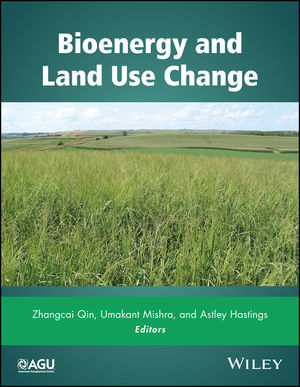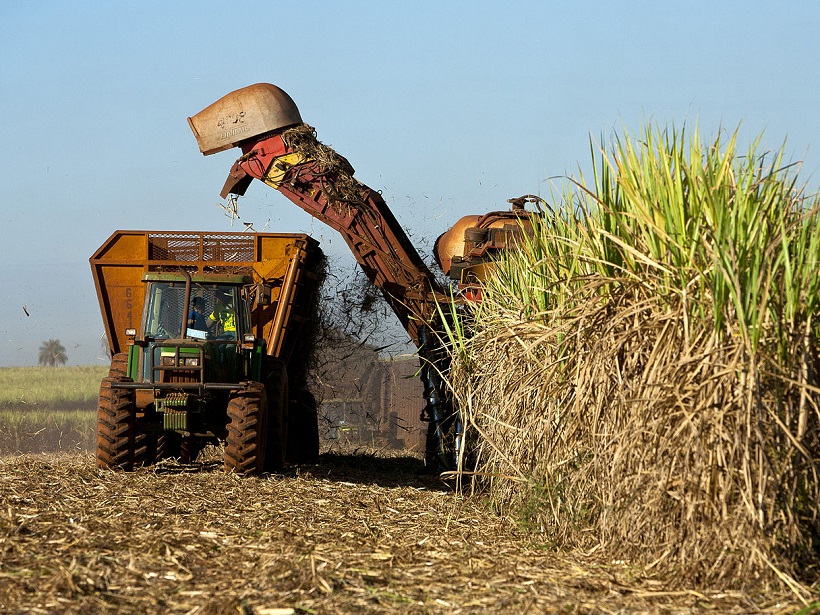Bioenergy has emerged as a significant form of renewable energy but the cultivation of crops specifically for use as bioenergy feedstocks changes the landscape, affects ecosystems, and impacts the climate. A new book, Bioenergy and Land Use Change, just published by the American Geophysical Union, reviews land use change related to bioenergy and the environmental impacts on regional and global scales. Here, the editors answer some questions about how bioenergy is changing the landscape.
What is bioenergy and why is it important?
Bioenergy is a general term referring to any energy derived from biological materials such as wood, crops, straw, food waste, and algae. Sometimes the term “biofuel” is used interchangeably with bioenergy. These biological materials, or “feedstocks,” store solar energy through photosynthesis, which is later converted to more usable forms of energy.
While conventional fossil fuels, such as gasoline and coal, are depleting the Earth’s natural resources, bioenergy can be renewable and sustainable. Bioenergy recycles atmospheric carbon dioxide, whereas fossil fuels add geologically stored carbon to the atmosphere. In addition, producing bioenergy has the potential to reduce other air pollutants, while still providing the same amount of energy.
Two of the major concerns facing human societies in the twenty-first century can be addressed by bioenergy that is properly produced and used. First, energy security can be improved by using a renewable and sustainable resource; second, reduction of greenhouse gas emissions can be achieved as bioenergy recycles atmospheric carbon. That being said, bioenergy’s environmental impacts need to be fully evaluated, which includes concerns such as land use change.

How is bioenergy production changing land use?
Many of the resources that can be used for bioenergy, such as corn, are already used to feed humans and animals.
If additional supplies are required specifically for bioenergy production, then more land may be needed to cultivate it. This land may come from using croplands already in use or from converting natural forest or grasslands.
Such a shift of land usage is called land use change.
Is it possible to quantify the amount of land that has been converted to bioenergy feedstocks production?
This is a very challenging topic. Scientists have made considerable efforts to quantify land use change that has occurred historically and is likely to occur in the future. Many different techniques have been adopted for this purpose including surveys, remote sensing, and modeling. However, when it comes to any particular cause of land use change, the questions become much more complicated.
Changes that occur in a parcel of land can be detected by the aforementioned techniques but many activities could happen during a given time period and contribute directly or indirectly to the land use change. Thus it becomes very difficult, if not impossible, to attribute such changes to any specific causes, especially when land use change occurred at large spatial scale.
For bioenergy, economic modeling has been used traditionally to identify specific land use change resulted from bioenergy production, however caution should be exercised regarding its validity and representativeness.
What are the impacts of land use change on the environment?
Land use change alters plant type, and with it factors such as biomass production, soil nutrient levels, and soil carbon content. In turn, these influence processes such as carbon emission or sequestration. For bioenergy, its impacts on greenhouse gas emissions are of particular interest.
Bioenergy is regarded as less carbon intensive than fossil fuels, meaning that it has the potential to reduce carbon dioxide emissions (or, more accurately, greenhouse gas emissions) if replacing fossil fuels. However, land use change to grow the bioenergy feedstock may affect bioenergy’s total emissions. Depending on what the specific land use change is, it may cause carbon loss from forest vegetation, and from soils (forest and natural grassland), or carbon gain due to growing energy crops, and better farming practices. Similarly, land use change can result in changes of emissions of methane and nitrous oxide, the other two important greenhouse gases that may contribute to bioenergy’s total greenhouse gas emissions.
In a nutshell, land use change for bioenergy production may impact the environment and eventually determine whether certain forms of bioenergy are actually sustainable or not.
What are some of the uncertainties or challenges in this field of research?
Our understanding of bioenergy and land use change has improved a lot during recent decades, however, there are still some critical questions unresolved or not fully addressed, and some new challenges. Just to name a few:

How can land use change be accurately quantified and associated with bioenergy production? How should models (economic or ecosystem models) be validated to estimate land use change and associated impacts?
What should be included for estimating bioenergy’s climate impacts, and how should they be estimated? Besides greenhouse gas emissions, what should be further considered in determining bioenergy sustainability?
What are the roles of economy and policy in bioenergy associated land use change?
This book examines these debates from different perspectives and, more importantly, encourages broader discussion of emerging and unresolved issues.
Bioenergy and Land Use Change, 2017, 208 pp., ISBN: 978-1-119-29734-5, list price $169.95 (hardcover), $135.99 (e-book)
—Zhangcai Qin and Umakant Mishra, Argonne National Laboratory, USA; and Astley Hastings, University of Aberdeen, UK; email: [email protected]
Citation:
Qin, Z.,Mishra, U., and Hastings, A. (2017), Bioenergy’s impacts on the landscape, Eos, 98, https://doi.org/10.1029/2018EO089309. Published on 20 December 2017.
Text © 2017. The authors. CC BY-NC-ND 3.0
Except where otherwise noted, images are subject to copyright. Any reuse without express permission from the copyright owner is prohibited.

